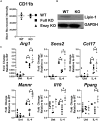Lipin-1 Contributes to IL-4 Mediated Macrophage Polarization
- PMID: 32431707
- PMCID: PMC7214697
- DOI: 10.3389/fimmu.2020.00787
Lipin-1 Contributes to IL-4 Mediated Macrophage Polarization
Abstract
Macrophage responses contribute to a diverse array of pathologies ranging from infectious disease to sterile inflammation. Polarization of macrophages determines their cellular function within biological processes. Lipin-1 is a phosphatidic acid phosphatase in which its enzymatic activity contributes to macrophage pro-inflammatory responses. Lipin-1 also possesses transcriptional co-regulator activity and whether this activity is required for macrophage polarization is unknown. Using mice that lack only lipin-1 enzymatic activity or both enzymatic and transcriptional coregulator activities from myeloid cells, we investigated the contribution of lipin-1 transcriptional co-regulator function toward macrophage wound healing polarization. Macrophages lacking both lipin-1 activities did not elicit IL-4 mediated gene expression to levels seen in either wild-type or lipin-1 enzymatically deficient macrophages. Furthermore, mice lacking myeloid-associated lipin-1 have impaired full thickness excisional wound healing compared to wild-type mice or mice only lacking lipin-1 enzymatic activity from myeloid cell. Our study provides evidence that lipin-1 transcriptional co-regulatory activity contributes to macrophage polarization and influences wound healing in vivo.
Keywords: lipin-1; macrophage; polarization; transcriptional coregulator; wound healing.
Copyright © 2020 Chandran, Schilke, Blackburn, Yurochko, Mirza, Scott, Finck and Woolard.
Figures







Similar articles
-
Macrophage-Associated Lipin-1 Promotes β-Oxidation in Response to Proresolving Stimuli.Immunohorizons. 2020 Oct 19;4(10):659-669. doi: 10.4049/immunohorizons.2000047. Immunohorizons. 2020. PMID: 33077427 Free PMC article.
-
Macrophage-Associated Lipin-1 Enzymatic Activity Contributes to Modified Low-Density Lipoprotein-Induced Proinflammatory Signaling and Atherosclerosis.Arterioscler Thromb Vasc Biol. 2018 Feb;38(2):324-334. doi: 10.1161/ATVBAHA.117.310455. Epub 2017 Dec 7. Arterioscler Thromb Vasc Biol. 2018. PMID: 29217509 Free PMC article.
-
Lipin-1 restrains macrophage lipid synthesis to promote inflammation resolution.J Immunol. 2025 Jan 1;214(1):85-103. doi: 10.1093/jimmun/vkae010. J Immunol. 2025. PMID: 40073265
-
Lipins, lipinopathies, and the modulation of cellular lipid storage and signaling.Prog Lipid Res. 2013 Jul;52(3):305-16. doi: 10.1016/j.plipres.2013.04.001. Epub 2013 Apr 17. Prog Lipid Res. 2013. PMID: 23603613 Free PMC article. Review.
-
Epigenetic modulation of macrophage polarization- perspectives in diabetic wounds.J Diabetes Complications. 2018 May;32(5):524-530. doi: 10.1016/j.jdiacomp.2018.01.015. Epub 2018 Feb 7. J Diabetes Complications. 2018. PMID: 29530315 Review.
Cited by
-
Role of lipins in cardiovascular diseases.Lipids Health Dis. 2023 Nov 14;22(1):196. doi: 10.1186/s12944-023-01961-6. Lipids Health Dis. 2023. PMID: 37964368 Free PMC article. Review.
-
Spatial and phenotypic heterogeneity of resident and monocyte-derived macrophages during inflammatory exacerbations leading to pulmonary fibrosis.Front Immunol. 2024 Jul 19;15:1425466. doi: 10.3389/fimmu.2024.1425466. eCollection 2024. Front Immunol. 2024. PMID: 39100672 Free PMC article.
-
Inflammation Resolution: Implications for Atherosclerosis.Circ Res. 2022 Jan 7;130(1):130-148. doi: 10.1161/CIRCRESAHA.121.319822. Epub 2022 Jan 7. Circ Res. 2022. PMID: 34995137 Free PMC article. Review.
-
Enterobactin inhibits microbiota-dependent activation of AhR to promote bacterial sepsis in mice.Nat Microbiol. 2025 Feb;10(2):388-404. doi: 10.1038/s41564-024-01882-9. Epub 2025 Jan 8. Nat Microbiol. 2025. PMID: 39779878 Free PMC article.
-
Lipin-1 restrains macrophage lipid synthesis to promote inflammation resolution.bioRxiv [Preprint]. 2023 Oct 25:2023.10.23.563587. doi: 10.1101/2023.10.23.563587. bioRxiv. 2023. Update in: J Immunol. 2025 Jan 01;214(1):85-103. doi: 10.1093/jimmun/vkae010. PMID: 37961352 Free PMC article. Updated. Preprint.
References
-
- Jennewein C, Kuhn AM, Schmidt MV, Meilladec-Jullig V, von Knethen A, Gonzalez FJ, et al. Sumoylation of peroxisome proliferator-activated receptor gamma by apoptotic cells prevents lipopolysaccharide-induced NCoR removal from kappaB binding sites mediating transrepression of proinflammatory cytokines. J Immunol. (2008) 181:5646–52. 10.4049/jimmunol.181.8.5646 - DOI - PMC - PubMed
Publication types
MeSH terms
Substances
Grants and funding
LinkOut - more resources
Full Text Sources
Other Literature Sources
Molecular Biology Databases

